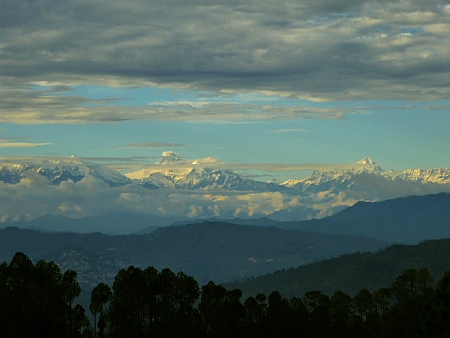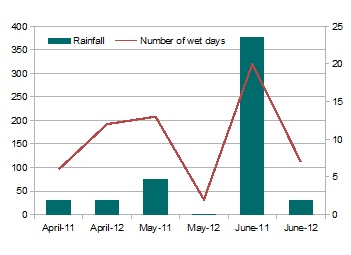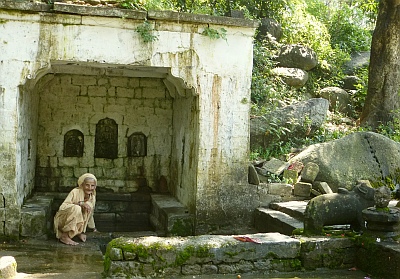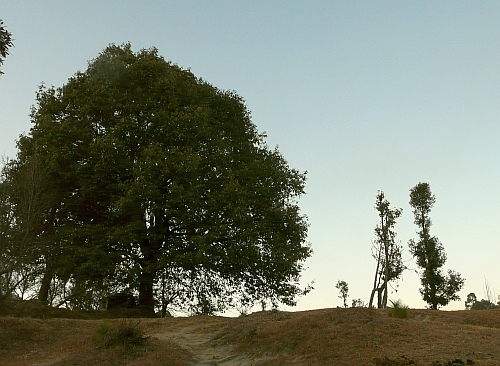CHIRAG has been working in the Kumaon area for the last 25 years, and is working on recharge springs. This report presents a study of the impact of this programme on 5 such springs. It presents both qualitative and quantitative data in the form of community feedback and discharge measurements.
This report also presents an interesting case study of a community-led water and conflict management system (Balyali spring) and empirical evidence of the impact of broad-leaf forests on ground water recharge (Bhadyun Dhara) in addition to presenting the details and impact of spring recharge measures.

The distinctive fold geology of the Himalayas shape the lives of mountain communities (Image: Chicu Lokgariwar)
The lives of mountain communities are greatly influenced by Himalayan geology. This geology is shaped by the laminated nature of Himalayan rocks, and the folds into which they are shaped. These combine to give rise to several springs, which according to their nature, are locally classified as 'naula', 'dhara', and 'bawdi'. Several organizations in the Himalayas are making a concentrated and science-based effort to halt this decline and rejuvenate these traditional water sources.

Graph showing rainfall and number of rainy days for the last two years (Image: CHIRAG)
The figure above illustrates the decrease in rainfall this year as compared to the last. This is of significance when one considers that the organization has still been receiving positive feedback from the villagers about the springs.
The following points are general information about the springs presented in the report:
- The springs included in this report are fracture springs with Phyllite and Quartzite/Gneiss/Schist rock type.
- The catchment areas range from 2 to 4.3 ha, and catchment area treatment was carried out on these.
- This work was focused on the dip slope and along the fractures.

Naulas like this one are an indispensable part of mountain life (Image: Chicu Lokgariwar)
The springs surveyed and the key observations are as follows:
Balyali spring
The Balyali Shivmandir Naula is considered the main drinking water source of the village.
Spring geology: Fracture spring structurally controlled by a set of longitudinal fractures running in the direction of 110-290 degrees.
Work done: The catchment area is 2.5 ha, with a dip of 20-44 degrees towards the NE. Interventions focused on water recharge structures namely percolation pits and khals, with some terrace leveling and bunding.Work was started in December 2010.
Community feedback: Till about 2 years ago, water shortage was the norm with strict rationing of water carried out in the summer. The mechanism of this rationing is explained in the report and is an interesting example of community led conflict management and resolution.
Despite this, the water would be insufficient. For 2011 and 2012, the water has been sufficient as the naula has not run dry. Discharge values for the naula for the last two summers have been included. The effect of this recharge treatment has also trickled down to a spring further downstream which was earlier dry, but has now started yielding some water.
Gajar spring
This spring is located in Kafaldhari hamlet, and the maximum water availability in summer was 15-20 lpcd.
Spring geology: This is structurally controlled by a set of longitudinal fractures running in the direction of
Towards N-S/ NNW-SSE. The aquifer has medium transmissivity.
Work done: Work over the catchment area of 4 ha was started in June 2011. Khals, percolation pits, and contour trenches were focused on.
Community feedback: While the spring is perennial, water has been scarce in the summer with only 3-4 canisters of water available then. This year, despite the drought, it has been yielding 5-6 canisters of water. Similarly, the spring has become more responsive to rainfall, possibly due to enhanced recharge.
Bhadyun Dhara
This spring has been the main source of water for the village. This was perennial about 30-35 years ago, but since then has had water only from July-March. This coincided with illegal lopping and felling of the Banj-oak forest located in the recharge zone of the spring. This provides empirical evidence of the importance of oak forests for groundwater recharge.
Spring geology:This was found to be a fracture spring established along the axis of a set of parallel and closely placed fractured caused by the folding of the rock beds. It is structurally controlled by a set of longitudinal fractures running in the direction of North-west & South-East.
Work done: Work on the 2.3 ha catchment area focused on brushwood check dams, percolation pits, and contour trenches. Some plantation, grass planting and terrace leveling and bunding was also done.
Community feedback: The year before the spring recharge programme was carried out, the dhara had dried up in the summer. However, in 2012, despite the lack of rainfall the dhara has been meeting the needs of the families in the village. The community also recognizes the need to plant broad-leaved trees in the recharge zone as also the need to maintain khals and contour trenches.

Healthy oaks like the one on the right are necessary for healthy groundwater systems (Image: Chicu Lokgariwar)
Chopra spring
Chopra Bhauna Naula is a perennial spring about a kilometer from the village. During the lean period, it is the only source of water in the village.
Spring geology: It is a fracture spring structurally controlled by a set of longitudinal fractures running in the direction towards NE-NNE.
Work done: In the 2 ha recharge zone,work began in November 2010. Focus was laid on implementing water recharge structures like percolation tanks/ponds/pits/sub surface checkdams etc.
Community feedback: Despite the very low rainfall this year, the measured discharge this June was consistent with that last year. The villagers state that the water levels were higher this year than in 2011. Some farmers felt that the soil moisture levels in their fields are higher post-treatment than earlier.
Nawali spring
This is located downhill from the village and is the main source of water for the community. While the dhara is perennial, in the lean period the discharge levels are less then than 1 lpm.
Geology: This is a fracture spring established along the axis of a set of parallel and closely placed fractured caused by the folding of the rock beds.
Work done: Work on the spring began in March 2010 with the commencement of soil & water conservation measures such as percolation tanks/ponds/pits; brushwood check dams and contour trenches etc along with terrace contouring.
Community feedback: According to the villagers, the water level had fallen dramatically 8-10 years ago and they had to fetch water from the stream. However, in June 2012, the 17 families that use the spring were able to draw around 200 litres per day.
Download the report from CHIRAG's site here.
Visit CHIRAG's website, for more info about their work.
/articles/spring-water-recharge-programme-study-post-programme-impact-kumaon-region-uttarakhand